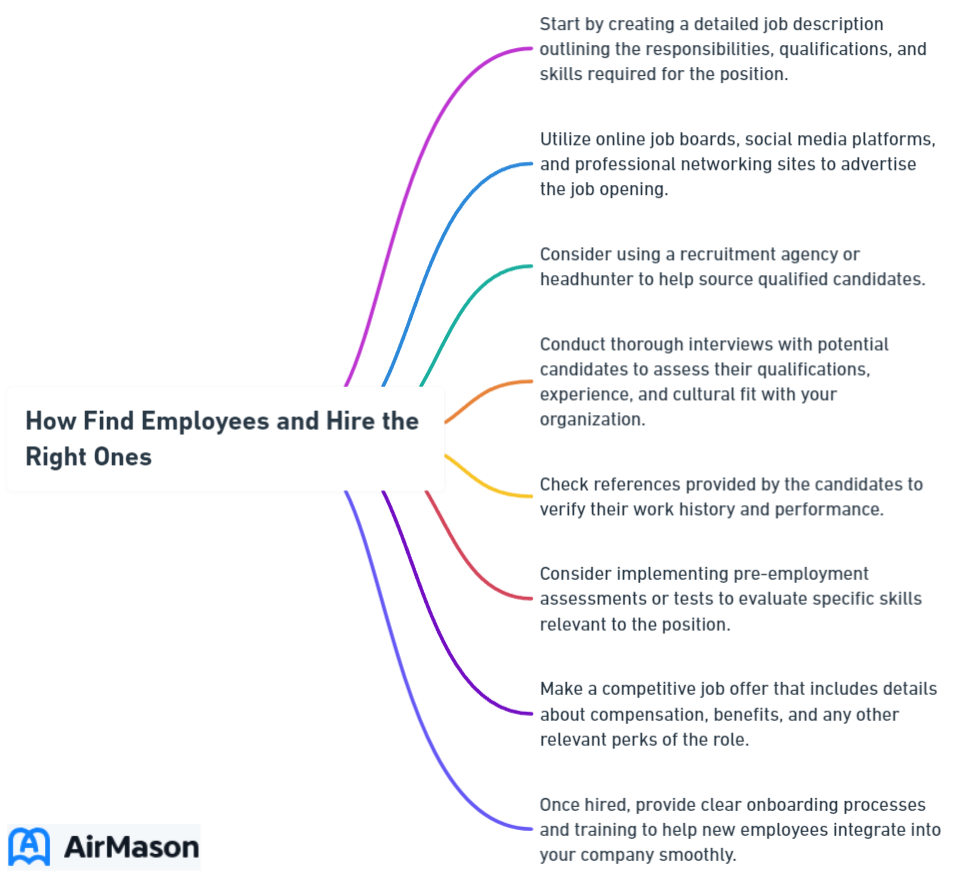
Hiring the right employees is critical to the success of any business. With today’s rapidly changing job market, it’s more important than ever to tap into various methods and tools for finding employees who will be a great fit for your company. In this blog post, we will discuss different strategies for how find employees, such as utilizing job boards effectively, harnessing the power of social media for recruitment, leveraging employee referral programs, partnering with educational institutions and non-profits, identifying potential in candidates, and streamlining the hiring process with technology.
Key Takeaways
- Harness the power of job boards, social media and employee referral programs to find qualified candidates who align with your company values.
- Assess potential employees’ skills, traits and cultural fit for successful integration into the workplace.
- Streamline recruitment efforts using technology such as applicant tracking systems, video interviews and remote onboarding solutions.
Employee Definition
In the realm of workforce dynamics, the term “employee definition” holds paramount significance. The employee definition encapsulates the fundamental characterization of an individual engaged in an official capacity within an organization. It encompasses the rights, responsibilities, and expectations that bind both the employer and the employee in a mutually agreed-upon professional relationship. This definition serves as a foundational framework, delineating the boundaries and parameters that guide the interactions and obligations within the workplace. Understanding the nuances of the employee definition is crucial for establishing clear communication, legal frameworks, and a harmonious work environment.
Utilizing Job Boards Effectively
Job boards serve as an essential bridge between employers and numerous qualified candidates. By selecting the right job board, crafting engaging job postings, and maximizing exposure, businesses can quickly find employees who align with their needs and company culture. Popular free job boards like Indeed and Glassdoor offer employers the opportunity to post listings, reaching a broad audience of job seekers. In fact, employers post job listings on these platforms to ensure they attract the most suitable candidates for their open positions.
However, choosing a job board should involve careful consideration of your industry, location, and target demographic. For example, niche job boards, such as Behance, Dribbble, and Krop, cater specifically to creative industries and might be a better fit for attracting candidates with the desired skillset. By employing multiple job boards, you can expedite the recruitment process, save time, and increase your chances of finding the right employees.

Selecting the Right Job Board
When choosing the right job board, consider factors such as the industry you’re in, the location of your business, and your target audience. For instance, businesses seeking hourly employees might find success on local job boards, Facebook groups, or websites like Craigslist. Additionally, paid job boards offer advanced features such as applicant tracking and online questionnaires, which can help streamline the hiring process.
Not all job boards are created equal, and some may be more suitable for your needs than others. For example, ZipRecruiter, a paid job board, requires a minimum daily cost of $16 per job, but it may be worth the investment for businesses seeking a more tailored platform. Meanwhile, Craigslist can be an affordable option, drawing in dozens of applicants and targeting users based on location. Ultimately, selecting the right job board will depend on your unique requirements and the type of candidates you wish to attract.
Crafting an Engaging Job Posting
Drawing highly qualified candidates necessitates engaging job postings. To create an impactful job posting, consider the following:
- Emphasize your company culture, benefits, and necessary skills.
- Be mindful of language that has traditionally been used to exclude certain groups of people from the job application process.
- Strive to make your job postings inclusive.
An effective job description should accurately depict the qualifications, experience, and skills necessary to succeed in the role, as well as the job title. Furthermore, it should provide an overview of the company’s culture and benefits, giving potential candidates an insight into the organization. By crafting well-written job descriptions, you enhance your chances of attracting top talent who align with your company’s values and vision through each job posting.
Maximizing Job Post Exposure
Consider using SEO-friendly language, promoting on social media, and exploring paid options to enhance job post visibility. Optimizing job ads for search engines can be achieved by adhering to fundamental rules such as using language optimized for search engine optimization (SEO). Some of the best SEO strategies include utilizing relevant keywords, optimizing the URL, and generating backlinks through social media.
Maximizing exposure not only increases the chances of attracting highly qualified candidates but also ensures that your job postings reach a broader audience. By investing time and effort in optimizing your job postings, you’ll be able to find employees more effectively and efficiently.
Harnessing Social Media for Recruitment

Given that an estimated 92% of employers use social media for recruitment and hiring, effective utilization of these platforms is vital. By leveraging social media platforms such as LinkedIn, Facebook, and Twitter, and showcasing your company culture, you can:
- Attract potential employees who align with your values and work environment
- Engage with prospective candidates
- Disseminate job postings quickly and efficiently
Social media platforms offer a unique opportunity to connect with and attract the right talent for your organization.
Besides using social media platforms for job postings, creativity and showcasing your company culture are key. For instance, a smaller real estate firm may have greater success sourcing potential candidates on LinkedIn and Twitter, while a restaurant or salon might benefit from experimenting with Instagram and even TikTok to highlight their distinct brand and offerings.
LinkedIn Recruiting
LinkedIn is a powerful tool for recruitment, offering advanced search features and networking capabilities to find and connect with potential candidates in your industry. By maintaining an active and engaging LinkedIn presence, you demonstrate your commitment to professionalism and industry expertise, making your business more attractive to potential employees.
Take advantage of LinkedIn’s features to connect with candidates who share your company’s values and goals. Here are some ways to do that:
- Reach out to potential candidates
- Engage in industry-related discussions
- Join relevant groups to build your network and demonstrate your company’s commitment to its field
A strong LinkedIn presence will not only help with recruitment but also enhance your overall brand reputation.
Facebook and Twitter Strategies
Utilizing Facebook and Twitter to find employees more effectively can be done in the following ways:
- Make it evident that you’re hiring in your bio or profile description
- Tweet or post authentic stories about your team to demonstrate your company culture
- Utilize applicable hiring and industry-specific hashtags to reach a broader audience
Moreover, by participating in conversations and engaging with potential candidates, you establish relationships that can lead to successful recruitment. Inquire whether potential candidates are on Twitter or Facebook and suggest reciprocal following to stay connected.
By actively engaging with potential employees, you create a strong social media presence that attracts top talent.
Showcasing Company Culture
The company culture is a significant factor in attracting and retaining the right staff, contributing to employee engagement and job satisfaction. Showcasing your company culture on social media platforms, such as Instagram and TikTok, can help you attract potential employees who align with your values and work environment.
To demonstrate company culture effectively, you can:
- Share testimonials from employees
- Utilize employee-generated content
- Post photos and videos that highlight your company culture
- Communicate transparently while recognizing and praising employees
By effectively showcasing your company culture on social media, you can attract candidates who are not only skilled but also a great fit for your organization.
Employee Expectations
Employee expectations play a pivotal role in shaping workplace dynamics and fostering a positive organizational culture. Clear communication of employee expectations is essential for creating a harmonious work environment. Employers must articulate these expectations transparently, covering aspects such as job responsibilities, performance standards, and professional conduct. By addressing and aligning with employee expectations, organizations can enhance job satisfaction, engagement, and overall productivity. Regular communication channels should be established to ensure that employee expectations are understood, met, and evolve in tandem with the organization’s goals and values.
Leveraging Employee Referral Programs

An employee referral program provides incentives to employees who successfully recommend potential hires. Leveraging employee referral programs can lead to:
- A faster hiring process
- Cost savings
- Access to superior candidates
- Heightened employee engagement
- Higher retention rates
- Enhanced performance.
Designing a successful employee referral program requires:
- Offering a mix of incentives to motivate employees to refer candidates
- Setting goals for the program to track its effectiveness
- Providing clear instructions on how to participate
By tapping into your current employees’ network, you can find qualified candidates who are more likely to be a good fit for your company.
Benefits of Referrals
Employee referrals can lead to faster hiring, better cultural fit, and higher retention rates compared to other recruitment methods. Referred candidates are 55% faster to hire than those sourced through career sites, and they tend to have an average retention rate of 46%, as opposed to the 33% retention rate for workers hired through other methods.
Tapping into your existing employees’ networks can help you find employees who are not only highly qualified but also compatible with your company’s values and culture. By leveraging employee referrals, you can save time, reduce costs, and improve the overall success of your recruitment efforts.
Designing a Successful Program
To design a successful employee referral program, follow these steps:
- Offer incentives such as cash bonuses, tangible items, or event tickets to motivate employees to refer potential candidates.
- Set clear guidelines for participation, including eligibility criteria and referral submission deadlines.
- Provide regular updates on the program’s progress to keep employees engaged and informed.
By implementing these strategies, you can create an effective employee referral program that encourages your employees to refer qualified candidates.
Moreover, make the referral process easy and straightforward, ensuring that employees can submit referrals without hassle. Emphasize the importance of referrals based on skills, perspectives, and values, and promote the program and its incentives to create awareness among employees.
By designing an effective referral program, you can leverage your existing workforce to find employees who align with your company’s values and goals.
Partnering with Educational Institutions and Non-Profits

Partnering with educational institutions and non-profits can offer several benefits for your company:
- Access to a diverse pool of potential candidates
- Support for community initiatives
- Finding employees who are pre-vetted and possess the skills and expertise you need for your business
Collaborating with these organizations can help you achieve your hiring goals and contribute to the community.
Connecting with local colleges, universities, and non-profit organizations allows you to tap into their networks and resources to find employees who share your company’s values and goals. By partnering with these organizations, you not only access a broader pool of candidates but also contribute to the betterment of your community.
College and University Connections
Connecting with local colleges and universities can help you find potential employees by participating in job fairs, collaborating with career centers, and leveraging alumni networks. By building relationships with educational institutions, you can tap into their resources and networks to find employees with specific skills or interests.
Participating in college job fairs and collaborating with career centers allows you to:
- Engage with students and alumni who are eager to start their careers
- Showcase your company’s culture, mission, and values
- Attract top talent from these institutions
- Enhance the overall quality of your workforce.
Non-Profit Partnerships
Partnering with non-profit organizations can provide several benefits:
- Access to pre-vetted, skilled candidates
- Support for social causes in your community
- Leveraging their existing networks and expertise to find employees who align with your company’s values and goals
By collaborating with these organizations, you can enhance your recruitment efforts and make a positive impact in your community.
Identify non-profits that align with your company’s mission or values, have a notable network and presence in the industry you are recruiting for, or provide programs or services related to the skills or expertise you are searching for in candidates. By partnering with non-profits, you not only find employees who are a perfect fit for your company but also contribute to the betterment of your community.
Identifying Potential in Candidates

Identifying potential in candidates requires a focus on key skills and traits, along with an assessment of their cultural fit within your organization. By evaluating a candidate’s values, work style, and compatibility with your company’s mission and vision, you can make informed hiring decisions that result in a more cohesive and productive team.
Evaluating potential candidates involves assessing their:
- problem-solving skills
- communication skills
- adaptability skills
- willingness to learn and grow
By focusing on these critical aspects, you can find employees who are not only highly skilled but also have the potential to thrive in your company’s unique work environment, making it easier to hire employees that fit your needs.
Skills and Traits to Look For

When identifying potential in candidates, look for individuals who possess:
- Strong problem-solving skills
- Effective communication skills
- Adaptability skills
- Eagerness to learn and progress
These traits are crucial for navigating and succeeding in a dynamic work environment.
Assessing a candidate’s problem-solving skills during an interview can be done by asking specific questions that evaluate their ability to analyze and solve problems. Additionally, pay attention to a candidate’s communication style and how they handle different work situations. By focusing on these skills and traits, you can find employees who will thrive in your company and contribute to its success.
Assessing Cultural Fit
Assessing a candidate’s cultural fit is just as important as evaluating their skills and experience. To evaluate a candidate’s cultural fit, consider their values, work style, and compatibility with your company’s mission and vision. This can help ensure that the candidate will not only be successful in their role but also contribute positively to your company’s overall culture.
During the interview process, inquire about their working environment preferences, problem-solving techniques, and communication style to get a better understanding of their work style and cultural fit. By assessing cultural fit, you can find employees who align with your company’s values and contribute to a positive and cohesive work environment.
Streamlining the Hiring Process with Technology
![]()
The use of technology can enhance the efficiency and scalability of the hiring process for businesses. By using applicant tracking systems (ATS) and incorporating video interviews and remote onboarding, you can optimize your recruitment efforts and save time, resources, and costs.
Utilizing technology in your hiring process offers several benefits:
- Improved efficiency
- Accommodation of candidates from various locations
- Easier identification of employees who are a perfect fit for your company By embracing these tools, you can stay ahead in the competitive job market and attract top talent to your organization.
Applicant Tracking Systems
Applicant tracking systems (ATS) are computer software programs that facilitate the hiring process by:
- Collecting, organizing, and tracking job applicants
- Managing job postings
- Tracking candidate progress
- Automating communication throughout the hiring process
Implementing an ATS can help make the hiring process more efficient and scalable for businesses.
By using an ATS, you can streamline your recruitment process and focus on finding the best candidates for your company. This not only saves time but also ensures that you have a comprehensive database of candidate information for future reference, making it easier to find employees when new positions become available.
Employee or Employees
In any organization, understanding the needs and concerns of the workforce is crucial for fostering a positive and productive work environment. Open communication channels and regular feedback sessions contribute to a better understanding of employee or employees‘ expectations, leading to increased job satisfaction and overall organizational success. Employers must pay close attention to the expectations of their employee or employees to ensure a harmonious workplace. By actively engaging with and addressing the diverse needs of the workforce, companies can build a culture of trust and collaboration.
Video Interviews and Remote Onboarding
Video interviews and remote onboarding tools can save time, reduce costs, and accommodate candidates from various locations. By utilizing video interviews, you can efficiently screen and interview candidates without the need for in-person meetings, making the hiring process more flexible and accessible.
Remote onboarding tools can also help streamline the onboarding process for new employees, allowing them to become integrated into the company and begin contributing to the team more quickly. By leveraging these technologies, you can find employees more effectively and efficiently, ensuring that your business continues to grow and succeed.
Summary
In conclusion, finding the right employees is crucial for the success of any business. By utilizing job boards effectively, harnessing social media for recruitment, leveraging employee referral programs, partnering with educational institutions and non-profits, identifying potential in candidates, and streamlining the hiring process with technology, you can attract top talent to your organization and ensure a productive and cohesive work environment. Embrace these strategies and tools to stay ahead in the competitive job market and build a team that will contribute to your company’s success.
Frequently Asked Questions
How do I find employees of a company?
To find new employees, use strategies such as creating a detailed job post, reviewing other job postings, posting on job boards, leveraging your social media presence, creating a career page on your company website, going to job fairs, asking your employees for referrals and giving interns and entry-level employees a chance.
How do most companies find employees?
Most companies find employees by posting job listings on a job search engine or other online and offline job boards, in addition to advertising at career fairs and utilizing current employees for recruitment.
Is it still hard for employers to find employees?
It is clear that employers are facing unprecedented challenges to fill open job positions, as there are 9.6 million job openings but only 6.4 million unemployed workers. Finding employees remains a difficult task for employers.
What are some popular free job boards for posting job listings?
Indeed and Glassdoor are two of the most popular free job boards for posting job listings, making them ideal choices for employers.
How can I showcase my company culture on social media platforms?
Share employee testimonials, utilize content from your employees, and post photos and videos that represent your company culture to showcase it on social media platforms.